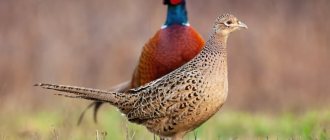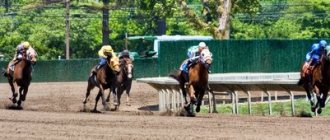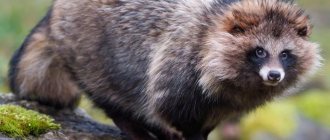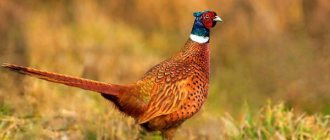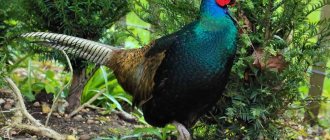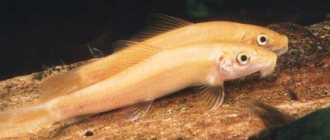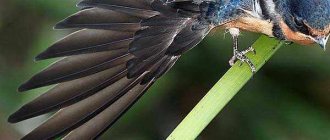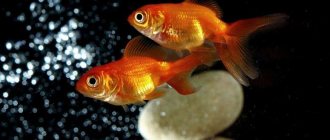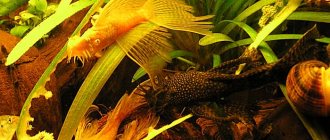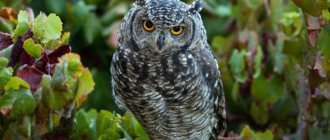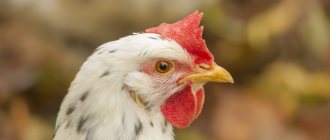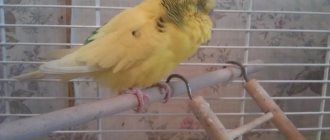- Wild animals
- >>
- Birds
The golden pheasant , sometimes called the Chinese pheasant, is one of the most beautiful birds in the world. It is popular among birders because of its stunningly brilliant plumage. This pheasant is naturally found in forests and mountainous environments in western China. Golden pheasants are ground-dwelling birds. They forage on the ground but can fly short distances.
Origin of the species and description
Photo: Golden Pheasant
The golden pheasant is a hardy game bird that belongs to the galliformes and is a small species of pheasant. The Latin name for the golden pheasant is Chrysolophus pictus. This is just one of 175 species or subspecies of pheasants. Its common name is Chinese pheasant, golden pheasant or artist's pheasant, and in captivity it is called the red golden pheasant.
The golden pheasant was originally classified as belonging to the genus Pheasantidae, which took the theological origin of the name from Phasis, the Colchis River, present-day Georgia, where the famous common pheasants lived. The current genus of collared pheasants (Chrysolophus) is derived from two ancient Greek terms "khrusos" - gold and "lophos" - crest, to correctly describe one of the specific characteristics of this bird and species from the Latin term "pictus" - drawn.
Video: Golden Pheasant
In the wild, two-thirds of golden pheasants will not survive 6 to 10 weeks. Only 2-3% will reach three years. In the wild, their lifespan can be 5 or 6 years. They live much longer in captivity, and with proper care, 15 years is common, and 20 years is not unheard of. In its native China, the golden pheasant has been kept in captivity since at least the 1700s. The first record of them in captivity in America was in 1740, and George Washington is said to have had several golden pheasants at Mount Vernon. In the 1990s, Belgian breeders raised 3 pure lines of golden pheasant. One of them is the yellow golden pheasant.
Fun Fact: Legend has it that during the Golden Fleece quest, the Argonauts brought some of these golden birds to Europe 1000 BC.
Field zoologists have noticed that golden pheasants are susceptible to bleaching if they are exposed to the sun for long periods of time. The shaded forests in which they live protect their bright colors.
Incubation
Often females do not sit on eggs, so the most suitable method of hatching chicks is incubation. Eggs should be collected immediately after the female has laid them. Typically, the longer the egg sits, the less likely it is for a chick to hatch.
Only large, smooth specimens without any damage are suitable for incubation. An ovoscope is used to check the quality of eggs. A good egg, suitable for breeding chicks, contains one yolk located in the center. There should be an air chamber at the tapered end of the egg.
Conditions for keeping eggs in the incubator:
| Incubation period, days | Temperature | Air humidity | Number of egg turns per day | Cooling eggs, number of times per day |
| 1-4 | 38 | 60-65% | 4 | – |
| 5-8 | 37,8 | 60-65% | 4 | – |
| 9-14 | 37,7 | 60-65% | 5 | – |
| 15-18 | 37,3 | 60-65% | 6 | 2 times, 15 minutes |
| 19-21 | 37 | 60-65% | 6 | 2 times, 15 minutes |
The chicks hatch on the 23rd or 24th day. There is no need to touch the eggs. The air temperature should be at least 37 degrees, humidity – 80 degrees.
Appearance and features
Photo: What a golden pheasant looks like
The golden pheasant is smaller than a pheasant, although its tail is significantly longer. Male and female golden pheasants look different. Males are 90-105 centimeters long, and the tail makes up two-thirds of the total length. Females are slightly smaller, 60-80 centimeters long, and the tail makes up half of the total length. Their wingspan is about 70 centimeters and they weigh about 630 grams.
Golden pheasants are one of the most popular captive species of all pheasants due to their beautiful plumage and hardy nature. Male golden pheasants are easily recognized by their bright colors. They have a golden crest with a red tip that extends from the head to the neck. They have bright red underparts, dark wings and a pale brown, long, pointed tail. Their buttocks are also golden, their upper backs are green, and their eyes are bright yellow with a small black pupil. Their face, throat and chin are red in color and their skin is yellow. The beak and paws are also yellow.
Fun fact: Male golden pheasants attract all the attention with their bright gold head and red crest, and bright scarlet chest.
Female golden pheasants are less colorful and duller than males. They have mottled brown plumage, a pale brown face, throat, chest and sides, pale yellow feet and are slimmer in appearance. Female golden pheasants have rufous brown plumage overall with dark stripes, making them nearly invisible when they are incubating their eggs. The color of the belly may vary among individual birds. Juveniles resemble the female, but have a spotted tail that has several red spots.
Thus, the main features of the appearance of the golden pheasant are:
- “Cape” - brown with dark edges, which gives the bird a striped appearance;
- upper back green;
- the wings are dark brown and very dark bluish, and the beak is golden;
- the tail is painted dark brown;
- eyes and paws are pale yellow.
Egg production
A few weeks before the interpretation, females begin to lay eggs. Egg production lasts about three months. During the first month, golden pheasants lay very few eggs, then a period of intense laying begins. During the entire breeding season, a female can lay up to 50 eggs. But this is only taking into account the daily extraction. Pheasant eggs are very similar in appearance to chicken eggs. The only difference is in size. Egg weight ranges from 25 to 35 g.
Females have poorly developed maternal instinct, so they do not survive the brood, abandoning their nests some time after laying.
For this reason, breeders use an incubator to hatch chicks. Since females lay eggs anywhere, eggs need to be collected daily.
Where does the golden pheasant live?
Photo: Golden Pheasant in Russia
The golden pheasant is a brightly colored bird native to central China. Some wild populations are found in Great Britain. This species is common in captivity, but these are often impure specimens, the result of hybridization with the Lady Amherst pheasant. Several mutations of the golden pheasant live in captivity, with different plumage patterns and colors. The wild type is known as the "red golden pheasant". The species was introduced by humans to England and Scotland. The first golden pheasants were brought to Europe from China at the end of the 19th century.
The wild golden pheasant lives in the mountains of Central China and is often found in dense forests. This shy bird usually hides in densely forested areas. This behavior may be a kind of natural protection for their bright plumage. In fact, these bright colors may fade if the bird is exposed to the sun for long hours during the day.
Interesting fact: The preferred habitats of the golden pheasant are dense forests and woodlands and sparse thickets.
Pheasants inhabit bamboo thickets in the foothills. Golden pheasants avoid swamps and open areas. They are surprisingly difficult to find in mixed and coniferous forests, where they quickly flee from detected danger. These birds live near agricultural lands and appear on tea plantations and terraced fields. For most of the year, golden pheasants live alone. With the onset of spring, their behavior changes and they begin to look for partners.
The golden pheasant lives at altitudes of no more than 1500 meters, and in winter it likes to descend along the valley floors in the forests of broad-leaved trees in search of food and to overcome unfavorable atmospheric conditions, but returns to its home territories as soon as a good season arrives. Apart from this small altitudinal migration, the golden pheasant is considered a sedentary species. Golden pheasants are now distributed in the United Kingdom and other parts of Europe, the United States and Canada, parts of South America, Australia and other countries.
Now you know where the golden pheasant is found. Let's see what this bird eats.
Diet
Pheasants eat a lot and often, so they will need a large amount of food.
Basic nutrition rules:
- In winter, the diet is structured as follows: 50% - grain mixtures and dry food mixed with broth;
- 20% – grated vegetables (carrots and cabbage);
- 16% – cottage cheese, minced meat, bone meal.
Additionally, vitamins are given to improve immunity.
- 45% grain crops (corn, barley and wheat);
What does the golden pheasant eat?
Photo: Golden pheasant bird
Golden pheasants are omnivores, which means they eat both plants and animals. However, their non-vegetarian diet mainly consists of insects. They forage on the forest floor in search of berries, leaves, seeds, grains, fruits and insects. These birds do not hunt in trees, but they may fly into branches to avoid predators or to sleep at night.
Golden pheasants feed primarily on grains, invertebrates, berries, larvae and seeds, as well as other types of vegetation, such as leaves and shoots of various shrubs, bamboo and rhododendron. They often eat small bugs and spiders. During the day, the golden pheasant feeds on the ground, walking slowly and pecking. It usually feeds early in the morning and late afternoon, but can move throughout the day. This species probably performs limited seasonal movements to search for food.
In Britain, the golden pheasant hunts insects and spiders, which probably form the majority of its diet, as the coniferous plantations in which it lives are devoid of undergrowth. It is also believed to consume large numbers of ants as it scratches through fallen pine litter. It also eats grain provided by keepers for the pheasants.
Thus, because golden pheasants move slowly as they peck along the forest floor for food, their diet consists of seeds, berries, grains and other vegetation, including rhododendron and bamboo shoots, as well as grubs, spiders and insects.
How long does it grow before slaughter?
Pheasant meat is considered a delicacy because it has high taste. Due to this, it is in great demand in the market. In the restaurant, the price for pheasant meat dishes is quite high.
A special breed of pheasants is bred for slaughter, which has high meat performance. Such individuals grow quickly and gain weight well. Birds weighing from 2-2.5 kg can be slaughtered. Pheasants gain this mass on average by 17 weeks.
Pheasant carcasses are difficult to find in supermarkets. You can only buy meat to order from breeders.
Features of character and lifestyle
Photo: Golden pheasant in nature
Golden pheasants are very timid birds that hide in dark, dense forests and wooded areas during the day and roost in very tall trees at night. Golden pheasants often forage on the ground despite their ability to fly, possibly because they are rather clumsy in flight. However, if they are hit, they are able to take off in a sudden, rapid upward movement with a characteristic wing sound.
Little is known about the behavior of the golden pheasant in the wild. Despite the bright colors of the males, these birds are difficult to spot in the dense, dark coniferous forests in which they live. The best time to view golden pheasants is very early in the morning when they can be seen in the clearings.
Golden pheasants' vocalizations include a "chuck-chuck" sound. Males have a special metallic call during the breeding season. Additionally, during an elaborate courtship display, the male spreads his neck feathers over his head and beak, and they are arranged like a cape.
Fun fact: Golden pheasants have a wide range of vocalizations, such as advertising, contact, and alarm, which are used in a wide variety of situations.
The golden pheasant is not particularly aggressive towards non-competing species and is relatively easy to tame with patience. Sometimes a male can become aggressive towards his female and even kill her. Fortunately, this happens very rarely.
How do they reproduce?
The mating season of birds starts in the spring. Males begin to sing inviting songs, attracting females. When contenders for the heart appear nearby, the “men” show them mating dances: they straighten their collars, twist their necks, fluff out their tails. In this position, the males spin in different directions so that the females can see their beauty from all sides. When several males are near the future “bride,” they have to fight.
In captivity, bird breeding proceeds in a different way, without the problems described above. In some cases, females do not sit on eggs, but this problem can be solved using a conventional incubator. Another option is to place eggs under a regular brood hen.
Attention! There is no better mother for her children than a female pheasant. Unlike a chicken, she is less active and careful with her eggs, and will never crush only the hatched offspring.
Social structure and reproduction
Photo: Golden pheasant in flight
Reproduction and egg-laying usually occur in April. During the breeding season, the male displays and enhances his superior plumage by posing and erecting himself and performing various movements in front of the female. During these displays, he spreads the feathers around his neck like a cape.
The female visits the male's territory in response to his call. A male golden pheasant darts around and fluffs up his feathers to attract a mate. If the female is not impressed and begins to leave, the male will run around her, trying to prevent her from leaving. As soon as she stops, he goes into full display mode, puffing out his cape and showing off his beautiful golden tail until he convinces her he's a good bet.
Interesting fact: Golden pheasants can live in pairs or trios. In the wild, a male may mate with several females. Breeders may provide them with 10 or more females depending on the location and conditions.
The laying of golden pheasant eggs occurs in April. Birds build their nest on the ground in dense bushes or tall grass. This is a shallow depression lined with plant materials. The female lays 5-12 eggs and incubates them for 22-23 days.
When hatched, the chicks are tan-colored from top to bottom with pale yellow stripes that are bright white underneath. Golden pheasants are early birds and can move and feed very soon. They usually follow adults to food sources and then peck the food on their own. Females mature faster than males and are ready to mate at one year of age. Males may be fertile at one year, but will reach maturity at two years.
The mother takes care of the children for a month until they are completely independent, even if they are able to feed themselves from the first day of life. However, the young remain with their mother in family groups for several months. Incredible is the fact that they can take flight just two weeks after birth, making them look like small quails.
Content
The golden pheasant requires special care and conditions. To breed birds, you will need a separate spacious aviary, which will be located away from noise and highways. The lemon pheasant behaves aggressively during mating games. Males begin to fight with each other, finding out who is stronger and more worthy of procreation.
Therefore, with the onset of the breeding season, which begins in April, families should be divided into 10 females and one male. Each family should be in a separate enclosure.
What maintenance do golden pheasants need:
- A quiet, dry area is best suited for breeding birds, in which you can build a warm poultry house with a canopy and a place for walking;
- For each family, an aviary measuring 1.5x2x2 m should be equipped. For walking birds, 10 m2 is enough;
- Many breeders equip the walls of the poultry house with fine galvanized mesh. It protects birds from rats and other small rodents, which can become a source of infection for the livestock with various infections;
- There should be warm bedding on the floor that will protect the pheasants from the cold;
- The rear wall of the poultry house must be insulated with special heating materials. At night, birds need absolute darkness;
- It is better to equip perches a meter from the floor;
- Walking areas must be fenced with metal mesh and covered with nylon material. Metal overhead structures can injure pheasants as they sometimes like to fly;
- For birds it is necessary to equip places for swimming, which are filled with a mixture of ash and sand;
- Walking areas must have at least one tree or small bush. Many breeders sow grass for pheasants every year;
- On warm nights, birds love to sleep on branches; you should not deprive them of this pleasure.
The recommendations for keeping this species described above apply only to large enclosures. If the birds are raised in small houses, they will have no need for unnecessary items. They will only interfere with the movement of birds and break off long tail feathers.
During nesting, females need a small separate hut, which will contain feathers, dry grass and branches. From all this they will build their own nests.
Natural enemies of golden pheasants
Photo: What a golden pheasant looks like
In the UK, golden pheasants are threatened by buzzards, owls, sparrowhawks, red foxes and other mammals. A study in the UK and Austria found nest predation by corvids, foxes, badgers and other mammals. In Sweden, golden pheasants have also been found to be preyed upon by goshawks.
Predators recorded in North America include:
- domestic dogs;
- coyotes;
- mink;
- caresses;
- striped skunks;
- raccoons;
- great horned owls;
- red-tailed hawks;
- red-shouldered hawks;
- Cooper's hawks;
- peregrine falcons;
- northern harriers;
- turtles.
Golden pheasants are susceptible to several nematode parasites. Other parasites also include: ticks, fleas, tapeworms and lice. Golden pheasants are susceptible to Newcastle disease virus infection. Between 1994 and 2005, outbreaks of this infection in golden pheasants were recorded in Denmark, Finland, France, Great Britain, Ireland, and Italy. Birds are also susceptible to respiratory diseases caused by coronaviruses that have been found to have a high degree of genetic similarity to chicken and turkey coronaviruses.
People like golden pheasants primarily because they look cute. Because of this, they enjoyed having them as pets for centuries, providing them with some protection. They are hunted by humans to some extent, but their population is stable. The bird's main threat is habitat destruction and capture for the pet trade. Although the golden pheasant is not at immediate risk of extinction, its populations are declining primarily due to habitat loss and overhunting.
Diseases
In captivity, pheasants are prone to disease. A healthy bird is active, has a good appetite and has an impeccable appearance. If any individual is suspicious, it must be carefully examined and, if necessary, isolated from other birds.
The most common viral diseases:
| Laryngotracheitis | Smallpox | Pseudoplague | Marek's disease | Salmonellosis | |
| Source | Sick or recovered bird | Sick or recovered bird | Sick bird | Sick bird | Sick or recovered bird |
| Transfer method | Food, water, equipment | Contact with infected birds through mucous membranes; ticks, bedbugs, rodents | Food, feathers, water, equipment | Water, food, feathers, dust, insects | Water, litter, equipment |
| Symptoms | Sneezing, coughing, shortness of breath, loss of appetite, decreased egg production, eggs have damaged shells | A sharp decrease in egg production, exhaustion, lack of appetite, wheezing, shortness of breath, eye inflammation, skin lesions | A sharp decrease in activity, lack of response to external stimuli, secretion of mucus from the beak, darkening of the skin on the head, liquid droppings, sometimes with blood | Paralysis of limbs, curvature of toes, deformation of the pupil, change in eye color | Lethargy, apathy, drowsiness, poor coordination of movements, inflammation of the eyes, intestinal disorders |
| Treatment | Antibiotics | Antiviral drugs, injections containing vitamin A, special ointments for affected skin areas | There is no treatment, the bird is disposed of | There is no treatment, the bird is disposed of | The bird is not treated, the sick individual is disposed of |
| Prevention | Vaccination | Vaccination | Vaccination | Vaccination | Providing nutritious feed and complying with sanitary standards |
Most common invasive diseases:
| Scabies | Pooh-eaters | Histomoniasis | |
| Source | Ticks | Lice | Insects, worms |
| Transfer method | Prolonged contact with infected birds | Mosquitoes and midges that carry the larvae of these parasites | Feed |
| Symptoms | The appearance of light growths around the beak and eyes, quickly spreading to the entire body. Baldness | The plumage is ruffled, itchy. An infected individual often shakes itself off. Decreased appetite | Lethargy, apathy, change in litter color, weight loss, darkening of scalp |
| Treatment | Cleansing the skin of crusts, treating the affected areas with ointment, adding vitamins to the water. | Equipment for sand baths with ash | Use of special drugs |
The most common non-communicable diseases:
| Dermatitis | Emphysema | Delayed oviposition | |
| Source | Bruises, wounds | Rupture of the lung walls | Insufficient intake of vitamins, feed, hypothermia, formation of eggs that are too large or eggs with too soft a shell |
| Symptoms | Skin irritation, itching, the bird pulls feathers from the irritated area | Swellings on the skin, when punctured, air escapes. Inactivity, heavy breathing, decreased appetite | Bloody droppings, abdominal tension to lay an egg |
| Treatment | Treatment of affected areas with iodine. Use of vitamin preparations | Placing a bird in a tight cage to limit its movements. Piercing swellings. Skin disinfection | Massage the abdomen, place the bird in a warm bath, rinse the cloaca with oil or fish oil, remove the egg |
- Parasites
- Infectious
- Other
Worms (helminths)
Roundworms that cause various diseases and, as a result, serious disorders in the body of birds
Read
Pere-eaters
How to deal with them using folk methods? How can I prevent parasites from appearing again?
Read
Mite
Diseases caused by the parasite. Symptoms, treatment, recommendations for prevention
Read
Newcastle disease (pseudoplague)
What is it and how to avoid infection? Main characteristics of the disease
Read
Pullorosis
Description of the disease, symptoms, treatment, preventive measures
Read
Aspergillosis
An infectious disease that affects the respiratory organs and leads to the death of the bird
Read
Psittacosis
Disease with severe respiratory disorders
Read
Salmonellosis
Symptoms of acute and permanent forms of the disease, treatment and prevention
Read
Colibacillosis
How to identify the source of the disease, how to cure a sick bird and immediately take preventive measures?
Read
Smallpox
Causes, symptoms of various forms, preventive measures and treatment methods
Read
Pecking
How does behavior disorder manifest itself, why is pecking dangerous and how to eliminate it?
Read
Rickets
A chronic disease characterized by impaired calcium-phosphorus metabolism
Read
Inflammation of the oviduct (salpingitis)
An inflammatory disease that can be effectively treated in the early stages. How to cure and restore egg laying?
Read
Commercial value
100 grams of pheasant meat contains up to 250 kcal, which is very nutritious, and its taste has been valued by people since ancient times. By eating pheasant meat, a person replenishes his body with many useful substances, which increases its resistance to various ailments, strengthening the immune system. Somewhere in the 19th century, these birds began to be bred artificially. They were used for hunting, for cooking, and also as decoration for the courtyards of rich nobility. As a rule, golden pheasants were used as decoration.
Pheasants were especially actively bred in the 20th century, when they were present in literally every private farmstead. Their owners received considerable profit from this, so a separate industry appeared - pheasant farming. These birds are bred in hunting farms, increasing their numbers closer to autumn, when the bird hunting season opens. As a result, a separate species of hunting pheasants appeared, which were bred as a result of crossing Chinese, Semirechensk and Caucasian species. You can get them on a private farm without any problems if you purchase chicks, which is not a problem in our time.
Photo gallery
Photo 1. Majestic Golden Pheasant
Photo 2. A flock of golden pheasants in the wild
Photo 3. Beautiful male with a yellow breast
Lifestyle
These birds are quite careful. As a rule, they live alone, less often in small groups. When danger arises, pheasants run away and only in extreme cases use their wings as defense. They spend the daytime on the ground, and at night they roost on the branches of tall trees.
Golden pheasants lead a sedentary lifestyle both in their homeland (China) and in Great Britain.
